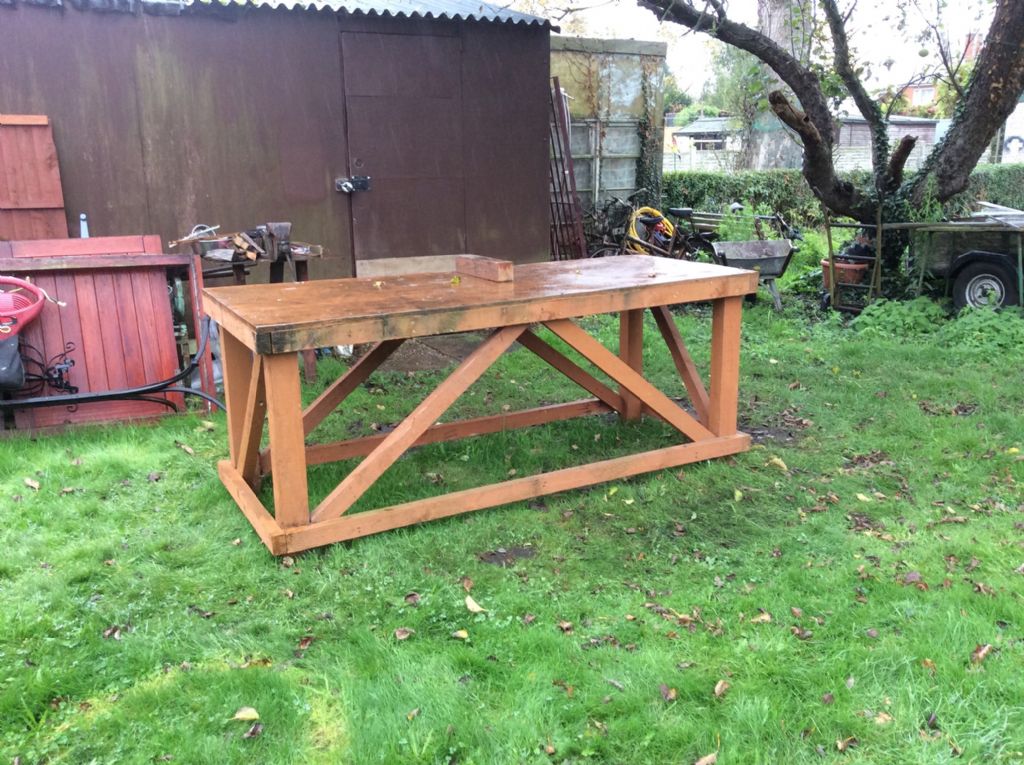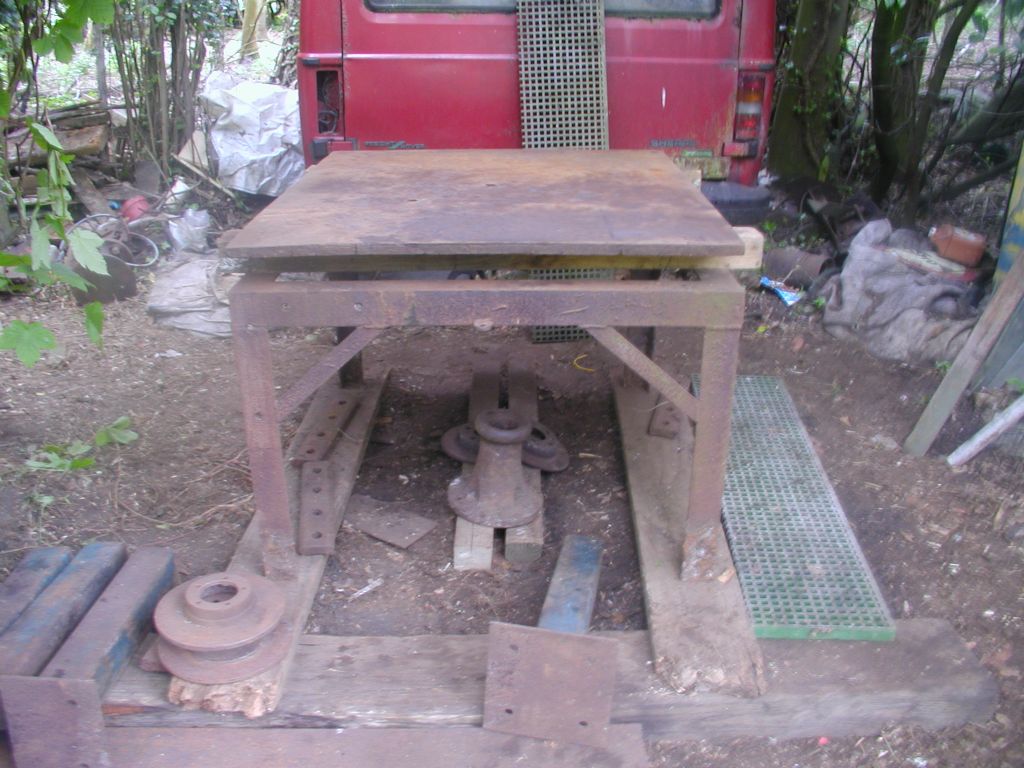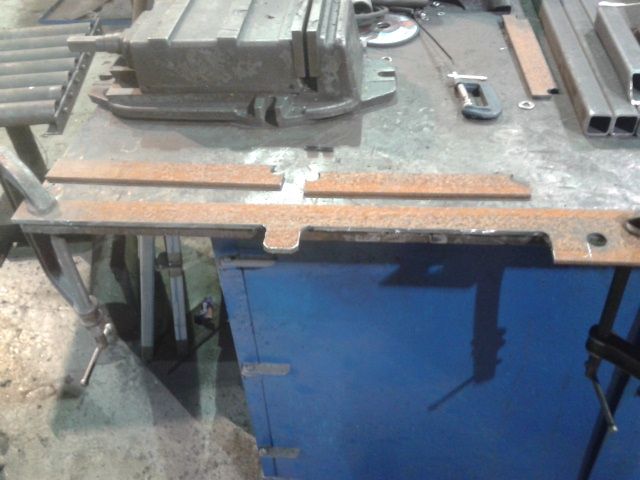Metal workbench
| Sonic Escape | 12/03/2023 18:35:55 |
194 forum posts 5 photos | Recently I started working with heavy metal objects and the tables I have are not suitable. Either they are not solid enough or they scratch easily. I thought of making a metal workbench. In my area there are 1x2m metal sheets 5mm thick. I already have four 100x100x3mm square pipes that I can use as legs. But I still need something to create rigidity. I have twelve meters of 4x50mm bar and I thought of welding a few pieces along the table. If I weld them on the edge, I think it will strengthen the board. I still don't know if it's a good idea.
|
| noel shelley | 12/03/2023 18:59:03 |
| 2308 forum posts 33 photos | 5mm for the top and you will need little for reinforcing, 100 x 100 legs will be fine. Seems agood plan to me . Noel |
| Simon Williams 3 | 12/03/2023 19:11:56 |
| 728 forum posts 90 photos | Hi there, good evening. If you weld anything worthy of the name to the underside of your 5 mm sheet you will pull the top plate out of shape. Even stitch welds will do this to some extent. Maybe this won't be a concern, but a nice flat table top will elude you. I have a slightly smaller table with a 10 mm thick top welded to 50 mm sq box around the periphery, It's not too bad, but flat it ain't. I estimate it's crowned by about 1.5 mm. It was fabricated as a fly press table, so it's OK for what it was meant to be used for, I use it as a welding table but I have to keep away from the edges if I want to clamp anything to the top surface and keep it flat and square. I would make a nice stiff frame and keep the top of the frame as flat as possible. Then I'd fix the top on with say M6 countersunk screws through right angled brackets on the 4 x 50 ribs. A flat surface is a great deal more useful than a not quite flat surface... |
| Maurice Taylor | 12/03/2023 19:35:13 |
| 275 forum posts 39 photos |
Hi, I know this is not steel but I thought it would give you an idea of bracing needed to give it strength.This has had various heavy car parts on it including engines and gearboxes. It’s been outside for 5 years Maurice |
| Sonic Escape | 12/03/2023 19:49:48 |
194 forum posts 5 photos | Posted by Simon Williams 3 on 12/03/2023 19:11:56:
Hi there, good evening. If you weld anything worthy of the name to the underside of your 5 mm sheet you will pull the top plate out of shape. Even stitch welds will do this to some extent. Maybe this won't be a concern, but a nice flat table top will elude you. Thank you for the warning about welding. I want it to be as flat as possible. I'll consider the option to build a frame then. How is the surface of your table? Is is painted or how are you keeping it from rusting? I was thinking to glue on top a stainless steel sheet of equal size, maybe 0.3mm thick?
Edited By Sonic Escape on 12/03/2023 19:50:49 |
| peak4 | 12/03/2023 19:52:09 |
2207 forum posts 210 photos | As others have said above, welding directly to the 5mm sheet will likely pull it out of flat, but the 4x50mm bar should act as reasonable bracing for the legs; In my case I used 40mm square box section. p.s. when coming up with your measurements, don't forget to allow for the height and fixings for a decent bench vice if you intend to fit one. Edited By peak4 on 12/03/2023 19:59:23 |
| Simon Williams 3 | 12/03/2023 20:34:57 |
| 728 forum posts 90 photos | Posted by Sonic Escape on 12/03/2023 19:49:48:
How is the surface of your table? Is is painted or how are you keeping it from rusting? I was thinking to glue on top a stainless steel sheet of equal size, maybe 0.3mm thick? Hi again, some good advice here, As for keeping it from rusting, long ago I sanded the original black surface scale off the top plate, and it just gets a light dust over with the sanding disc from time to time. This takes any welding spatter off, and keeps the surface fresh. Otherwise I keep it lightly oiled. It's not perfect but it's good enough. HTH Simon PS being able to sit at the side of your new table is essential! edited for PS
Edited By Simon Williams 3 on 12/03/2023 20:37:14 |
| Bill Phinn | 12/03/2023 20:41:04 |
| 1076 forum posts 129 photos | Shown below is how Mac Industries [I have no connection with them] create a welding table surface that is likely to stay flat: |
| Nicholas Farr | 13/03/2023 00:34:24 |
3988 forum posts 1799 photos | Hi Sonic Escape, you only need enough short good runs of weld between the top and whatever you put it on. You don't say how heavy your heavy metal is, but as the others have said, your design will distort like a good-un, 10mm thick would be the minimum for any short of real fabrications or heavy stuff and 12mm thick would be better. If you really do have some heavy metal to work on, this is the sort of bench you want, with a good sturdy angle iron frame or a strong steel bench, which you can keep the gear you are doing any jobs with in. The top on this one is a little over 1M x 1.2M and 25mm thick, the angle iron is close to being 75mm X 75mm X 10mm. The legs on this will be coming off and the top frame made a little smaller, and those 100mm X 100mm hollow sections laying on the ground will be put on instead. The idea of making the frame a little smaller is so G-clamps can be used on the edges of the top more easily. If you got heavy metal, have a heavy bench. This is one end of the one I used in my final day job, and you can see how convenient being able to use G-clamps are on the edges of the top. Regards Nick. Edited By Nicholas Farr on 13/03/2023 01:05:13 |
| Jelly | 13/03/2023 00:57:55 |
474 forum posts 103 photos | I would suggest:
Et Voila, you have a flat sturdy workbench with a 5mm thick steel top. If you want to improve rigidity, there are two upgrades or one change you could make to your existing design:
Edited By Jelly on 13/03/2023 01:07:38 |
| Hopper | 13/03/2023 06:45:10 |
7881 forum posts 397 photos | How heavy are the "heavy metal objects" you will be putting on the bench? Your design with 5mm plate would be OK for most model engineering and say motorcycle engine rebuilding and that kind of medium duty work. But not so much for rebuilding bulldozer engines and the like or even maybe a full 7-1/2" gauge locomotive model. I would add some braces to the legs for sure though. Either around the legs near the bottom, or diagonal braces near the top of each leg going to the main frame under the bench top. If you weld the frame up good and solid, you should be able to attach the 5mm sheet to the top with small tack welds in multiple places without unacceptable distortion if you go carefully. It will not be a dead-flat surface table but should be ok for a general work bench. Bolting it with countersunk screws is a good idea if you want to be sure of dead flat. But it will only be as flat as the frame you make underneath of course. Edited By Hopper on 13/03/2023 06:46:59 |
| Clive India | 13/03/2023 10:10:35 |
277 forum posts | Sturdy old wooden workbence/table with sheet steel on top. Extra support as necessary from vertical tube? OR this baby with added tubular vertical support as required
Edited By Clive India on 13/03/2023 10:21:02 |
| Howard Lewis | 13/03/2023 10:30:23 |
| 7227 forum posts 21 photos | I would suggest that you make a complete frame from your square tube, Some diagonal braces will make it even stronger (You don't want the welds to pull the legs out of square with the top mframe. lastly, you can then clamp on the 5 mm top before welding tha along the edges. This is how the benches were constructed at work. Howard |
| Jelly | 13/03/2023 12:37:12 |
474 forum posts 103 photos | Posted by Clive India on 13/03/2023 10:10:35:
Sturdy old wooden workbence/table with sheet steel on top. Extra support as necessary from vertical tube? OR this baby with added tubular vertical support as required
Edited By Clive India on 13/03/2023 10:21:02 This would be my preferred option normally, but I get the impression Sonic would want to use it as a welding table.
An application where I have learned from experience that you can get wood smoldering hot underneath a large metal plate intended to protect it if you're doing a lot of bigger welds in PA/PB (flat) position with the back of the workpiece in direct contact with the table. Edited By Jelly on 13/03/2023 12:37:51 |
| Sonic Escape | 25/03/2023 17:13:33 |
194 forum posts 5 photos | Today I went to a local shop to buy the metal plate. The place is huge, I didn't knew about it before. They have all kind of metal plates and tubes. I decided on the spot to buy also some 40x80x2 rectangular tubes. There is a big difference when you see things in reality. The plate is very heavy, almost 80kg. But I was able to bring it from the truck into the garage with a wheelbarrow.
I cut all the pipes and the plan is to do something like this. I sent the picture to a friend who does the models for car crash simulations. He is familiar with the rigidity of the metal structures. He said that this should be solid
I will not weld the plate. Instead I'm thinking to glue it to the frame with Mamut glue. Is is very strong. I used it before. The legs are very rusty. So I cleaned them with a brush.
Then I used a phosphoric acid solution to convert the remaining rust and to prepare the surface for a primer. It is easier to do this before the legs are welded.
I found also a nice 125mm steel vise for the table. My initial favorite model was this. It has a lot of good reviews on Amazon but some people posted pictures with broken ones. Their cast iron must be brittle.
Is good that I let the legs outside to dry. Now it is raining ...
Edited By Sonic Escape on 25/03/2023 17:18:35 |
| Sonic Escape | 25/03/2023 17:35:54 |
194 forum posts 5 photos | Posted by Nicholas Farr on 13/03/2023 00:34:24:
Hi Sonic Escape, you only need enough short good runs of weld between the top and whatever you put it on. You don't say how heavy your heavy metal is, but as the others have said, your design will distort like a good-un, 10mm thick would be the minimum for any short of real fabrications or heavy stuff and 12mm thick would be better. If you really do have some heavy metal to work on, this is the sort of bench you want, with a good sturdy angle iron frame or a strong steel bench, which you can keep the gear you are doing any jobs with in. That looks like a very solid bench. But 5mm is the thickest plates available here. For 10mm or more I should order it and then the transport becomes more complicated. I will also add some diagonal tubes if the result is not rigid enough. The maximum weight that will sit on the desk is 150-200kg. I have a few old vacuum tubes military radios that weight 100kg each. Every time I was fixing something on them I was working on the floor. Also I'm working on a milling machine that might be heavier. I still don't know what to do with the surface. Now that black coating is very dirty and it sticks to everything. I want to remove it but then I suppose the plate will rust.
|
| Sonic Escape | 26/03/2023 20:28:51 |
194 forum posts 5 photos | The metal frame welding is 90% complete. Is feels very rigid. Next week-end I'm going to cut four square plates to cover each leg. And then I will glue a rubber sheet on each. The legs looks so ugly because of the rust converter liquid I used yesterday. But the surface is flat. I cleaned them with a rotating wire brush. I'm very pleased with the results so far.
|
| Jelly | 26/03/2023 21:37:41 |
474 forum posts 103 photos | That's looking like a very beefy workbench right there, definitely puts my welding table to shame. The braces on each leg are a particularly good move. Regards gluing the top in place, it's actually quite a good idea for flatness and rigidity... But just be aware of how your adhesive reacts to heat if you're planning to use it as a surface for welding on, or it may suddenly come loose.
|
| Sonic Escape | 01/04/2023 20:35:24 |
194 forum posts 5 photos | Today I painted the workbench frame with a primer:
And this is how it looks after the first layer of yellow Hammerite:
I painted also one side of the plate with a rust converter. This is the side that will be glued to the frame. After I will remove that white crust and paint it.
I'm not sure what to do with the top of the plate. I wanted to polish it and then to apply some Autosol paste. It will create a thin layer of wax. So it will not rust and it will not be greasy. But then it will be like a mirror and will reflect the light. Maybe I'll paint it with a spay with some matte color. When it gets scratched, it will be easy to repair. |
| Jelly | 01/04/2023 22:07:50 |
474 forum posts 103 photos | I would be inclined to use phosphoric acid (or a suitable phosphoric acid based rust treatment*) on the top of your table, wipe it down thoroughly and then apply a light machine oil or as you suggest a wax. The Iron Phosphate produced by the rust treatment will result in a dull black finish which is reasonably hard wearing and will retain a protective layer of oil or wax on the surface without being greasy to the touch. Painting the surface will not wear well, and most likely result in localised rusting wherever it gets scratched, giving you a worse long term outcome.
* Quite a few rust convertor products have a mix of weak phosphoric acid with a varnish or sealant, which is good for metal that will be painted, but would actually work against you when trying to prepare a surface of exposed "black phosphate" to be oiled/waxed for long term protection. Edited By Jelly on 01/04/2023 22:16:21 |
Please login to post a reply.
Want the latest issue of Model Engineer or Model Engineers' Workshop? Use our magazine locator links to find your nearest stockist!
Sign up to our newsletter and get a free digital issue.
You can unsubscribe at anytime. View our privacy policy at www.mortons.co.uk/privacy
- *Oct 2023: FORUM MIGRATION TIMELINE*
05/10/2023 07:57:11 - Making ER11 collet chuck
05/10/2023 07:56:24 - What did you do today? 2023
05/10/2023 07:25:01 - Orrery
05/10/2023 06:00:41 - Wera hand-tools
05/10/2023 05:47:07 - New member
05/10/2023 04:40:11 - Problems with external pot on at1 vfd
05/10/2023 00:06:32 - Drain plug
04/10/2023 23:36:17 - digi phase converter for 10 machines.....
04/10/2023 23:13:48 - Winter Storage Of Locomotives
04/10/2023 21:02:11 - More Latest Posts...
- View All Topics
- Reeves** - Rebuilt Royal Scot by Martin Evans
by John Broughton
£300.00 - BRITANNIA 5" GAUGE James Perrier
by Jon Seabright 1
£2,500.00 - Drill Grinder - for restoration
by Nigel Graham 2
£0.00 - WARCO WM18 MILLING MACHINE
by Alex Chudley
£1,200.00 - MYFORD SUPER 7 LATHE
by Alex Chudley
£2,000.00 - More "For Sale" Ads...
- D1-3 backplate
by Michael Horley
Price Not Specified - fixed steady for a Colchester bantam mark1 800
by George Jervis
Price Not Specified - lbsc pansy
by JACK SIDEBOTHAM
Price Not Specified - Pratt Burnerd multifit chuck key.
by Tim Riome
Price Not Specified - BANDSAW BLADE WELDER
by HUGH
Price Not Specified - More "Wanted" Ads...
Do you want to contact the Model Engineer and Model Engineers' Workshop team?
You can contact us by phone, mail or email about the magazines including becoming a contributor, submitting reader's letters or making queries about articles. You can also get in touch about this website, advertising or other general issues.
Click THIS LINK for full contact details.
For subscription issues please see THIS LINK.
Model Engineer Magazine
- Percival Marshall
- M.E. History
- LittleLEC
- M.E. Clock
ME Workshop
- An Adcock
- & Shipley
- Horizontal
- Mill
Subscribe Now
- Great savings
- Delivered to your door
Pre-order your copy!
- Delivered to your doorstep!
- Free UK delivery!
























 Register
Register Log-in
Log-in


